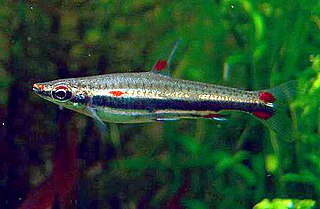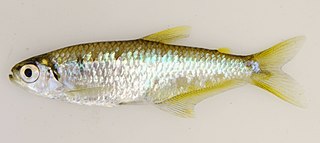| Planaltina | |
|---|---|
| Scientific classification | |
| Domain: | Eukaryota |
| Kingdom: | Animalia |
| Phylum: | Chordata |
| Class: | Actinopterygii |
| Order: | Characiformes |
| Family: | Characidae |
| Genus: | Planaltina J. E. Böhlke, 1954 |
| Planaltina | |
|---|---|
| Scientific classification | |
| Domain: | Eukaryota |
| Kingdom: | Animalia |
| Phylum: | Chordata |
| Class: | Actinopterygii |
| Order: | Characiformes |
| Family: | Characidae |
| Genus: | Planaltina J. E. Böhlke, 1954 |
There are currently 3 recognized species in this genus: [1]

Characidae, the characids or characins, is a family of freshwater subtropical and tropical fish belonging to the order Characiformes. The name "characins" is an historical one, but scientists today tend to prefer "characids" to reflect their status as a, by and large, monophyletic group. To arrive there, this family has undergone much systematic and taxonomic change. Among those fishes remaining in the Characidae currently are the tetras, comprising the very similar genera Hemigrammus and Hyphessobrycon, as well as a few related forms, such as the cave and neon tetras. Fish of this family are important as food in several regions, and also constitute a large percentage of captive freshwater aquarium fish species.

Hyphessobrycon is a genus of freshwater fish in the family Characidae. These species are among the fishes known as tetras. The genus is distributed in the Neotropical realm from southern Mexico to Río de la Plata in Argentina. Many of these species are native to South America; about six species are from Central America and a single species, H. compressus is from southern Mexico.
MQV (Menezes–Qu–Vanstone) is an authenticated protocol for key agreement based on the Diffie–Hellman scheme. Like other authenticated Diffie–Hellman schemes, MQV provides protection against an active attacker. The protocol can be modified to work in an arbitrary finite group, and, in particular, elliptic curve groups, where it is known as elliptic curve MQV (ECMQV).

Nannostomus is a genus of fish belonging to the characin family Lebiasinidae. All of the species in this genus are known as pencil fish, a popular name that was initially only applied to two species in the 1920s, Nannostomus unifasciatus and Nannostomus eques, by the late 1950s however, the term would be applied to all members of the genus. Several species have become popular aquarium fish due to their attractive coloration, unique shape, and interesting demeanor.

Jenynsia is a genus of freshwater fishes in the family Anablepidae. Like Anableps species, they are onesided livebearers: some sources indicate that they only mate on one side, right-"handed" males with left-"handed" females and vice versa. However, other sources dispute this. These South American fish are viviparous.
Priocharax is a genus of characins, very small freshwater fish from the Amazon and Orinoco basins in tropical South America.

Mugil is a genus of mullet in the family Mugilidae found worldwide in tropical and temperate coastal marine waters, but also entering estuaries and rivers.

Glandulocaudinae are a subfamily of tropical freshwater characin fish from Central and South America. In all species of this subfamily, a gland on their caudal fin is found almost exclusively in the males, which allows the release and pumping of pheromones; also, members of this subfamily have complex courtship behaviors which lead to insemination. The ecology and life history of these fish is complex yet little studied. Glandulocaudines are important as food fish for larger fish important for commercial and subsistence reasons.
Scoloplax is the only genus in the catfish family Scoloplacidae, the spiny dwarf catfishes.
Mimagoniates is a genus of characid fish from rivers and streams in southeastern, southern and central-western Brazil, northeastern Argentina, and Paraguay. The individual species generally have relatively small ranges and two, M. lateralis and M. sylvicola, are considered threatened by Brazil's Ministry of the Environment.

Thrichomys is a genus of South American rodents in the family Echimyidae. It contains at least five species, found in Bolivia, Brazil and Paraguay. They are as follows:

Diapoma is a genus of characins from tropical South America.
Glandulocauda is a genus of small characin freshwater fish that are endemic to Brazil, where restricted to the upper Paraná basin and coastal river basins in São Paulo state. The genus it is closely related to Lophiobrycon and Mimagoniates, and they form the tribe Glandulocaudini.
Knodus is a genus of characins, small freshwater fish from South America.
Monotocheirodon is a genus of characins native to tropical South America. The currently recognized species in this genus are:
Nematocharax is a genus of freshwater fish in the family Characidae. It contains the single species Nematocharax venustus, which is endemic to Brazil, where it is found in the Jequitinhonha River basin. The males of this species can reach a length of 5.1 centimetres (2.0 in) SL while the females only grow to 3.5 centimetres (1.4 in) SL.
Odontostilbe is a genus of characins from tropical Central and South America, with 19 currently recognized species:
Xenurobrycon is a genus of characins from tropical South America.
Stanley Howard Weitzman was a Research Scientist Emeritus at Division of Fishes, National Museum of Natural History, Washington, D.C.